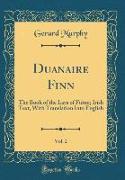- Start
- Duanaire Finn, Vol. 2
Duanaire Finn, Vol. 2
Angebote / Angebote:
Excerpt from Duanaire Finn, Vol. 2: The Book of the Lays of Fiónn, Irish Text, With Translation Into EnglishIn printing the text the following rules have been observed The mark of aspiration has been represented by h. Where in the MS a vowel has been written over a letter, r has often been inserted silently in the printed text between the letter and the super script vowel. 'where a consonant.has been written over a_letter, a has often been silently inserted. The well-known signs for ar, air, ach (each), co (can), cu, da, m, n, and as, have been ex panded silently, except in a few instances where it seemed advis able to indicatethe manuscript reading as precisely as possible. All other contracted syllables have been expanded in italics. When the as-sign stands for uis, the uis has been printed in italics. The ar-sign has been represented variously by ar, air, ar, air, always in italics. When a contracted syllable containing a long vowel has been expanded, whether silently or in italics, a makron has in certain cases been placed over the long vowel if there is no mark of length visible in the manuscript. The makron has in no instance been supplied over a syllable not contracted in the manu script. Where a contracted syllable containing an aspirated consonant has been expanded in the printed text, an h in square brackets, [h], has been used to indicate the aspiration if there is no dot over the mark of contraction in the manuscript. Square brackets have also been used in a few instances to supply a letter accidentally omitted by. The scribe in uncontracted syllables. Tall 6 before a broad consonant has been represented by ea where the syllable is short, by If (or e) where long. This is in conformity with the practice of the scribe, who, except in one or. Two instances, writes ea for the short sound and e' (or e) for the long, when he uses the small form of the letter 6 (in XXIV 11d he wrote e'a by mistakeand expressly deleted the a). For the diphthong commonly written ia the scribe often writes ie: this is always printed ie, whether the e in the manuscript be a tall or a small 6. The printed text does not follow the manuscript in word - division, the use of hyphens and apostrophes, or the use of capitals.About the PublisherForgotten Books publishes hundreds of thousands of rare and classic books. Find more at www.forgottenbooks.comThis book is a reproduction of an important historical work. Forgotten Books uses state-of-the-art technology to digitally reconstruct the work, preserving the original format whilst repairing imperfections present in the aged copy. In rare cases, an imperfection in the original, such as a blemish or missing page, may be replicated in our edition. We do, however, repair the vast majority of imperfections successfully, any imperfections that remain are intentionally left to preserve the state of such historical works.
Folgt in ca. 10 Arbeitstagen
